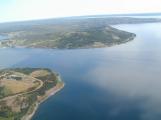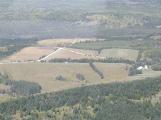1
Mural created for the 200th Anniversary of the arrival of the Barra settlers20th Century, Circa 2002
Iona, Victoria County, NS
 Credits:
Credits:Painted by Terry MacDonald
2
Soldiers were reported to be the first from the Island of Barra, Scotland, to see North America. The story of Donald "Og" MacNeil is well known amoung the MacNeils of Canada. This story exists in Gaelic as well as English. S. R. MacNeil, author of the book "All Call Iona Home - 1800 to 1950", and grandson of Donald Og, tells the story of Donald's travels. As part of the British army, in 1758 Donald was aboard a british ship sailing through the Bras d'Or Lakes to Spanish Bay, now Sydney, Cape Breton. They spotted a French frigate and noticing how low the ship was in the water, went in persuit. The chase took them across the Atlantic until they broke off the chase near the coast of France. As it was late in the year, the British ship tied up in England and the crew was sent home for the winter. Donald went home to Barra and told his family of the beauty of the Bras d'Or and the lands around it. He passed on his wish that if anyone left Barra and went to North America, they would settle on the Banks of Bras d'Or.3
The meeting20th Century, circa 2002
Barra Strait, Cape Breton, NS
 Credits:
Credits:Created by Terry MacDonald
4
In order to claim property, the four men had to plant stakes and clear some of the property of trees. This was a great task for them as they were not used to working with trees of this nature. When they were burning the brush, the First Nation people living nearby came to see what was happening. The Chief of the group asked what the Scots were doing. Donald MacNeil was the spoksman probably because he could speak French. He told them they were staking their claim to the land to be granted to them. Donald showed the Natives his paper from the King but the Chief did not consider this as legitimate. The land belonged to the Mi'maq and their people. It appeared that trouble was brewing.Eoin MacNeil fell to his knees and sought devine help with the sign of the cross. This caused the Chief to become friendly as he recoginzed the sign and asked if they were Catholics. Donald produced his crucifix and the Chief declared them all "brothers" as the natives too were Catholic having been converted by Jesuit priests. They shared a meal of eels and salt to cement their friendship.
5
Lives of the settlers20th Century, circa 2002
Barra Strait, Cape Breton, NS
 Credits:
Credits:Created by Terry MacDonald
6
The four MacNeils staked and cleared some property at the narrowest part of the Strait. They went back to Arisag, Antigonish County, for the winter and the next spring, 1802, came back to settle.7
Map of Cape Breton showing areas of Barra settlementCirca 1800-1840
Cape Breton Island, Nova Scotia
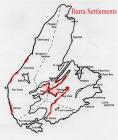 Credits:
Credits:Pauline MacLean
8
The map shown here gives an idea of where some of the Barra people settled in the first wave of emmigration.10
Remains of a homestead30 October 2000
MacKinnon's Brook, Inverness County, NS
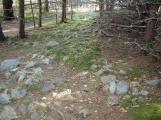 Credits:
Credits:Rodney Chaisson
11
The view from Cape Mabou, Cape Breton towards Mabou Harbour30 October 2000
Mabou Harbour, NS
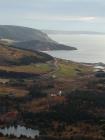 Credits:
Credits:Rodney Chaisson
12
These two shots are of the remains of settlements of Barra people, the family of Hugh MacKinnon, in the MacKinnon's Brook area of Inverness County. The settlement was situated high above the sea on a plateau and included a brook running to the gulf from which small boats could be landed.13
MacKinnon's Brook homestead30 October 2000
MacKinnon's Brook, Inverness County, NS
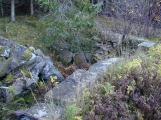 Credits:
Credits:Rodney Chaisson
